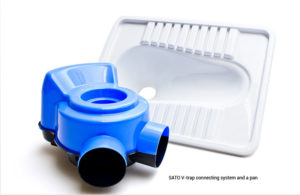SATO -A smart, hygienic and a water saving technology for toilet. Billions of people are living without safe water, utilizing contaminated water for their survival. As a result of this, they tend to fall seriously ill – and are unable to access or afford healthcare services. SATO, a smart and affordable toilet solution for rural-semi-urban settings, will reduce the consumption of water.
World Water Day : Friday, 22 March, 2019
Today, billions of people are living without safe water – their households, schools, workplaces, farms and factories are struggling to survive and thrive. Marginalized groups – women, children, refugees, indigenous peoples, disabled people and many others – are often overlooked, and sometimes face discrimination, as they try to access and manage the safe water they need. In keeping with this context, the theme for World Water Day this year is ‘Leave No One Behind’.
An adaptation of the central promise of the 2030 Agenda for Sustainable Development (SDG6), the theme states that as sustainable development progresses, everyone must benefit. In 2010, the United Nations recognized ‘the right to safe and clean drinking water and sanitation’ as a human right that is essential for the full enjoyment of life and all human rights. The human right to water entitles everyone, without discrimination, to sufficient, safe, acceptable, physically accessible and affordable water for personal and domestic use; which includes water for drinking, personal sanitation, washing of clothes, food preparation, and personal and household hygiene.
Over 2.3 billion people globally cannot access basic sanitation, which results in an estimated $260 billion of economic loss annually. India accounts for 60 percent of all people in the world without access to sanitation. While one section of our country needs to be educated on why a toilet is important, a large part of the Indian population continues to practice open defecation, primarily because of two reasons – they do not have access to either toilets, or their toilet systems do not address the challenges they face while installing, maintaining and using them. India faces two major challenges – first is waste generation and its management, and the second is lack of access to a basic sanitation facility. Approximately 47,000 Twin-Pit Pour-Flush (TPPF) latrines are built in India every day, but most require more than five litres to flush and feature a junction box for switching between pits that is prone to clogging.
The SATO V-trap connection system also requires approximately 500 ml water per flush. SATO has also been recommended by the Government of India’s Dr. Mashelkar Committee on sanitation as a water saving technology. As per Delhi Science Forum, taking the example of Delhi, calculations done by DSF say that that current usage of water for flushing toilets is about 20 litres per household of five person per day. By providing a reliable, hygienic and an affordable toilet solution, SATO has been successful in encouraging people to use toilets. The new generation of SATO uses an innovative V-trap configuration connecting the twin pits.
By providing a reliable, hygienic and an affordable toilet solution, SATO has been successful in encouraging people to use toilets in the rural areas as it is designed specifically for rural and peri-urban areas.


How does SATO – A smart, hygienic and a water saving technology for toilet?
- It provides a safe space for women and children who step out of their houses at odd hours to defecate in the open.
- SATO ensures safety in terms of health by providing a hygienic infrastructure that will prevent spread of several diseases amongst the communities – by preventing open defecation ultimately reducing the contamination of the surrounding soil and water.
- SATO establishes a ‘Swachh’ habitat for the communities. Community members will be sensitised towards the importance of cleanliness and eventually open defecation, as a practice, will be frowned upon.
- As a ripple effect, fewer cases of diarrhoea, increased labour efficiency, safer and cleaner environment, amongst others will be witnessed. Hence, positively influencing the socio-economic landscape in the country.
- With sanitation being a major health issue, and given that huge economic losses are borne by the country due to poor sanitation, it is integral that innovations in the sanitation sector be made available to all.
- In terms of total cost, India suffers a lot due to poor sanitation. In 2015, US$106.7 billion of India’s GDP was wiped – off due to poor sanitation. This is equivalent to 5.2% of India’s GDP.
- For every US $1 invested in water and sanitation, US $4.30 is generated in economic returns through increased productivity.


Ms. Priyanka Tanwar,
Head of Public Affairs,
LIXIL- Asia Pacific











